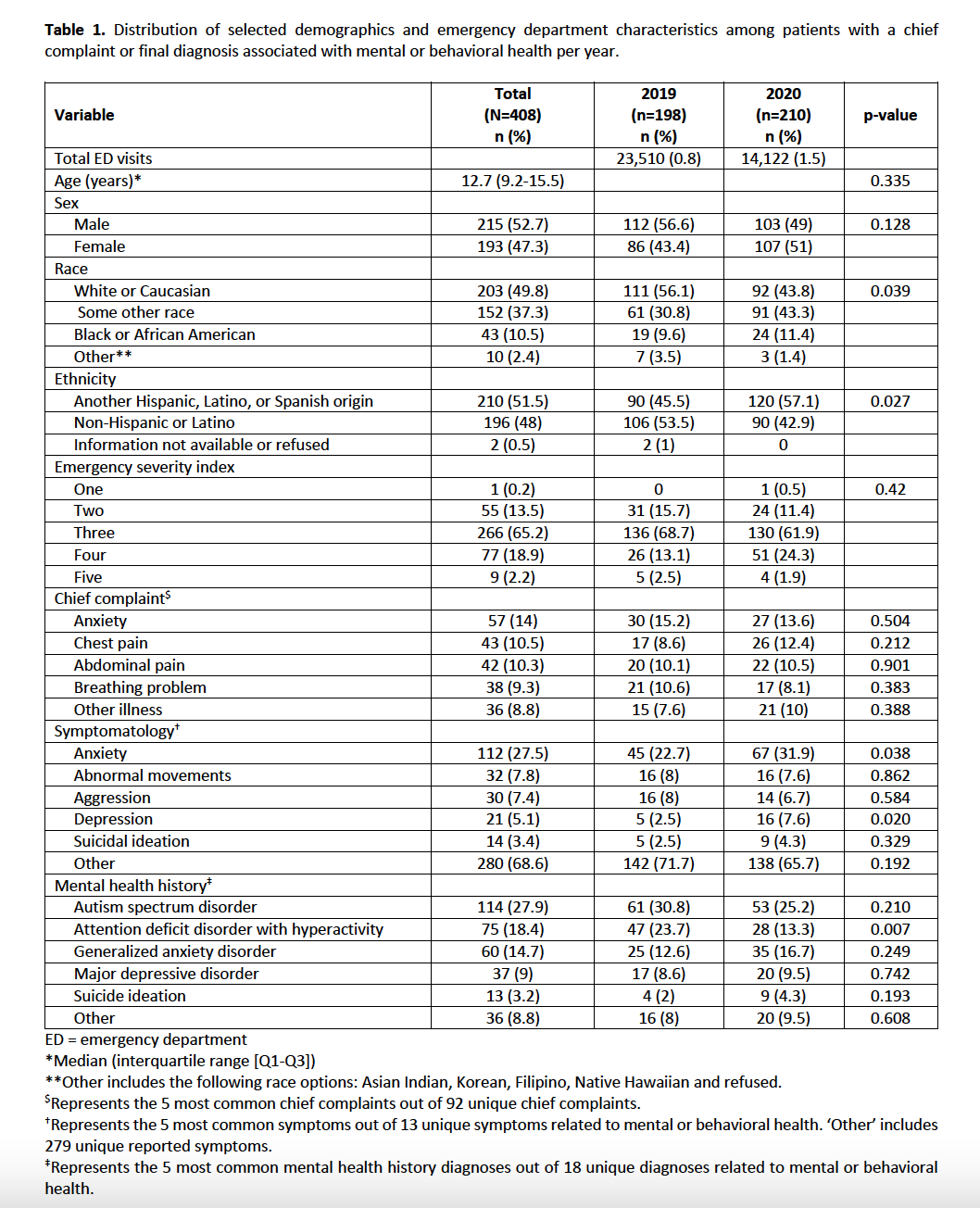Back
Emergency Medicine: All Areas
Category: Abstract Submission
4: Emergency Medicine I
37 - Changes in Pediatric Emergency Department Mental Health Cases During the Progression of the COVID-19 Pandemic
Friday, April 22, 2022
6:15 PM – 8:45 PM US MT
Poster Number: 37
Publication Number: 37.103
Publication Number: 37.103
Andrea Rivera-Sepulveda, Nemours Children's Hospital, Orlando, FL, United States; Ridhwan Mohammad, University of Central Florida College of Medicine, Kissimmee, FL, United States; Cara Harwell, Nemours Children’s Hospital, Polk City, FL, United States; Monet Winslow, Nemours Children's Hospital, Orlando, FL, United States; Audrey T. Bowen, Nemours CHildren’s Health, Florida, Orlando, FL, United States

Andrea Rivera-Sepulveda, MD, MSc
Assistant Professor
Nemours Children's Hospital
ORLANDO, Florida, United States
Presenting Author(s)
Background: Pediatric behavioral health cases have increased in the U.S, with an increasing prevalence in mental health disorders associated with the COVID-19 pandemic. The general and financial stress, social isolation, and fear of contracting COVID-19 are risk factors that can exacerbate behavioral health disorders in children and adolescents. School closures and decreased outpatient services during the pandemic have resulted in a decrease of accessible mental health and counseling services. The emergency department (ED) serves as a critical resource for many patients who seek emergent care for their behavioral health needs.
Objective: To describe the trend in the pediatric ED visits for mental and behavioral health during the COVID-19 pandemic.
Design/Methods: This is a retrospective, cross-sectional study of children ages 4 to 18 years who had an ED visit with a chief complaint or a final diagnosis related to mental/behavioral health, from January 1st, 2019 to December 31st, 2020. Chi-square, Fisher’s exact test, and independent samples T-tests were used, as appropriate.
Results: We identified 408 patients who met the inclusion criteria. From 2019 to 2020, there was an increase in mental/behavioral health visits from 0.8% to 1.5%, albeit not significant. Median age was 12.7 years (IQR 9.2-15.5 years). Most common chief complaints were anxiety, chest pain, abdominal pain and breathing problem. Anxiety (27.5%, p=0.038) and depression (5.1%, p=0.020) were the most commonly reported symptoms in 2020, compared to 2019. A third (33.8%) presented with a mental/behavioral health complaint; however, twice as many (65.4%) patients had a final diagnosis related to mental/behavioral health (p < 0.001). About 13% had a history of previous hospitalizations due to mental/behavioral health. About 12% reported compliance with home medications, with 82.7% compliance unknown. There was no significance in the use of medications or restraints during the ED visit. Social work consult was the most common ED resource (61.4%). Three percent were transferred to a psychiatric facility, and 79.9% were discharged home. Median length of stay was 180 minutes (IQR 116.5-268.75 minutes).Conclusion(s): Most patients visited the ED for complaints perceived as organic, that after careful evaluation are mental/behavioral health related. This asserts the importance of an ED visit for mental and behavioral health evaluation. A better understanding of mental/behavioral health cases presenting to the pediatric ED improves preparedness and allocation of resources and enable encouragement of patients to seek care when vital.
Distribution of selected demographics and emergency department characteristics among patients with a chief complaint or final diagnosis associated with mental or behavioral health per year.
Objective: To describe the trend in the pediatric ED visits for mental and behavioral health during the COVID-19 pandemic.
Design/Methods: This is a retrospective, cross-sectional study of children ages 4 to 18 years who had an ED visit with a chief complaint or a final diagnosis related to mental/behavioral health, from January 1st, 2019 to December 31st, 2020. Chi-square, Fisher’s exact test, and independent samples T-tests were used, as appropriate.
Results: We identified 408 patients who met the inclusion criteria. From 2019 to 2020, there was an increase in mental/behavioral health visits from 0.8% to 1.5%, albeit not significant. Median age was 12.7 years (IQR 9.2-15.5 years). Most common chief complaints were anxiety, chest pain, abdominal pain and breathing problem. Anxiety (27.5%, p=0.038) and depression (5.1%, p=0.020) were the most commonly reported symptoms in 2020, compared to 2019. A third (33.8%) presented with a mental/behavioral health complaint; however, twice as many (65.4%) patients had a final diagnosis related to mental/behavioral health (p < 0.001). About 13% had a history of previous hospitalizations due to mental/behavioral health. About 12% reported compliance with home medications, with 82.7% compliance unknown. There was no significance in the use of medications or restraints during the ED visit. Social work consult was the most common ED resource (61.4%). Three percent were transferred to a psychiatric facility, and 79.9% were discharged home. Median length of stay was 180 minutes (IQR 116.5-268.75 minutes).Conclusion(s): Most patients visited the ED for complaints perceived as organic, that after careful evaluation are mental/behavioral health related. This asserts the importance of an ED visit for mental and behavioral health evaluation. A better understanding of mental/behavioral health cases presenting to the pediatric ED improves preparedness and allocation of resources and enable encouragement of patients to seek care when vital.
Distribution of selected demographics and emergency department characteristics among patients with a chief complaint or final diagnosis associated with mental or behavioral health per year.

